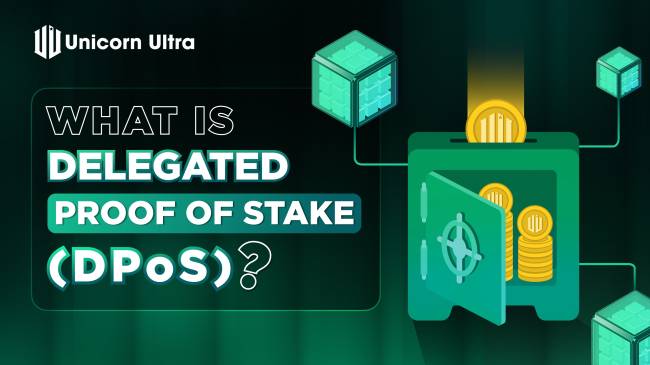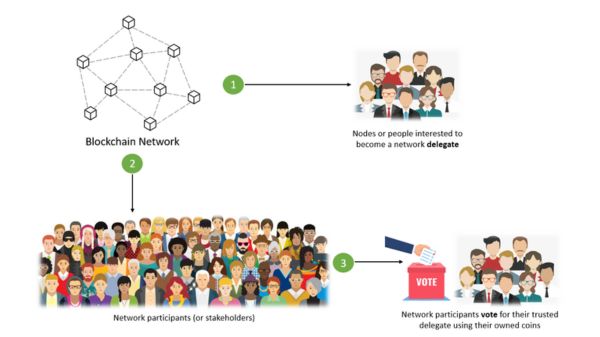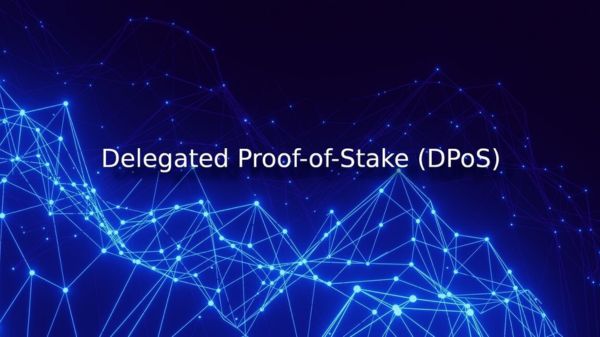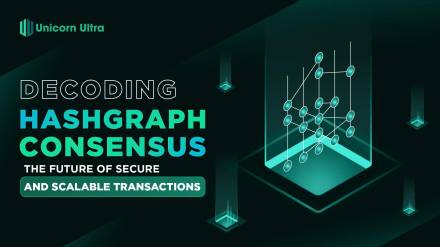Distributed ledgers like blockchain or hashgraph require consensus mechanisms to reach uniform agreement on the network state. The most widely known consensus mechanisms are Proof of Stake (PoS) and Proof of Work (PoW), used by the Ethereum and Bitcoin blockchain, respectively.
However, over a long period of time, these original, long-lived methodologies are proved to be flawed and nonoptimal. Consequently, more innovative approaches have arisen, bringing about more complicated but productive systems. At U2U Chain, Delegated Proof of Stake (DPoS) is one of the three consensus techniques that we implement in our “Triple Layer Protection Mechanism” to greatly improve our chain’s performance as well as security.
In this article, we will delve into Delegated Proof of Stake to learn about what is Delegated Proof of Stake, how it works, and how it is a better initiative compared to PoS and PoW.
Table of Contents
What is Delegated Proof of Stake (DPoS)?
What is Delegated Proof of Stake (DPoS)? Delegated Proof of Stake is a modified version of Proof of Stake, arguably a more efficient and democratic one. Delegated Proof of Stake is similar to Proof of Stake in the sense that both follow a collateral staking system whereas the native network tokens are staked for security purposes.
Nevertheless, DPoS improves the preceding mechanism by adding a voting and delegation process. This addition offers a more affordable, efficient, and fair way to validate transactions. In DPoS, all token holders can participate in the network and benefit from it; On the other hand, in original PoS blockchains, the value accrues to stakers/validators.

The development of DPoS
The concept of DPoS, as a variation of PoS, was first introduced by Daniel Larimer in 2014. He outlined this novel consensus mechanism in a Bitcointalk forum post. Larimer's vision was to create a more efficient and scalable consensus algorithm that could address some of the limitations of traditional PoS systems.
The DPoS concept gained practical implementation and recognition with the launch of BitShares in 2015, a cryptocurrency platform developed by Daniel Larimer. BitShares was one of the first blockchain projects to adopt the DPoS consensus algorithm.
DPoS did not remain confined to BitShares but saw further adoption in other blockchain projects. Notably, Steem and EOS embraced DPoS as their consensus mechanism. EOS, in particular, garnered substantial attention for its use of DPoS and conducted one of the largest initial coin offerings (ICOs) in the cryptocurrency space.
How does DPoS work?
In a PoS system, all nodes are involved in the workflow of the blockchain. However, DPoS involves an election system for users to vote on some specific delegates responsible for verifying and creating blocks. In this procedure, there are 4 participants: Voters, Witnesses/Block Producers, Delegates, and Validators.

Voters
Every network participant holding even the least amount of native token can become a voter. Ultimately, voters are the ones who decide the most important matters in the network, from choosing a Witness or Delegate to concluding governance proposals. Users with voting power can either cast their own votes, or delegate this right to another person. The voting power will be directly proportional to the amount of capital they have.
The most concerning task for a voter is to select the Witnesses/Block Producers since they are directly involved in the block production process.
Witnesses/Block Producers
The nodes that are voted by token holders are called Witnesses, or Block Producers. These entities are responsible for validating transactions and creating blocks on the blockchain. Upon successful verification of all transactions in one block, the responsible witnesses receive rewards, which are then partially distributed back to the users who voted for them.
On the other hand, if a Witness fails to verify all transactions in the allotted time and misses a block, they would not receive any reward. Generally, the reward for a failed Witness may be passed on to the next Witnesses if they verify all transactions. Such a process would imply that the block is “stolen”.
In this way, there are incentives for both parties to act truthfully and benefit from their behaviors: users (token holders) would want to vote for a trustworthy node to earn a portion of the network reward, while Witnesses would want work honestly to earn their reputation, attract more voters, hence participating in the block production process for rewards.
Interestingly enough, one does not need a large amount of capital to become a Witness. Instead, Witnesses are heavily ranked by reputation. As the voting process happens continually, Witnesses have to constantly grow their reputation and integrity to stay relevant. Since the number of selected Witnesses is usually limited at 21-101 depending on the blockchain, the competition among these peers becomes more tremendous as the network grows.
Delegates
Delegates are another entity that are selected by users’ votes. However, unlike Witnesses who are responsible for block production, Delegates take charge of the governance. Their job is to put out improvement proposals for the network, for example changing the size of a block, or deciding the amount of block reward.
Ultimately, these proposals are voted on by users before being finalized. Delegates do not have the right to apply changes directly on the system.
Validators
Block Validators refer to full nodes who verify that blocks created by witnesses follow the consensus rules. Any user can become a Validator; unfortunately, there is no incentive to be one.
Advantages and Limitations of DPoS
While regarded as an improved version of PoS, DPoS still possesses its pros and cons.
Advantages
- Easily accessible: Everyone can participate in and benefit from a DPoS system without needing a large amount of capital or expensive equipment.
- Decentralized: With a low barrier of entry, the network will involve a massive number of participants, making it more decentralized, democratic, and financially inclusive.
- Highly performant and scalable: The number of Witnesses is limited, allowing the network to reach consensus much faster, resulting in a higher throughput.
- Sustainable and environmentally-friendly: DPoS systems require a low level of power to operate, making it sustainable and more environmentally-friendly.
Limitations
- Vulnerable to malicious behaviors: As Witnesses are voted by users and users are normally heavily driven by incentives, Witnesses can add bribes during the voting process to manipulate the system.
- Unreliable: A user-oriented system means it can be easily ruined if the participants (Witnesses, Delegates,...) do not behave correctly. Human behaviors are very unpredictable and incentive-driven by nature, which can be exploited or lead to inefficiencies.
- Centralization risks: While the network is decentralized in the sense that all users can participate in it, it can also be very centralized because there are only a small, limited number of Witnesses/Block Producers.

DPoS vs PoS vs PoW
As mentioned earlier, while PoS and DPoS are similar in the sense of stakeholding, DPoS presents a novel democratic voting system by which Block Producers are elected. Since a DPoS system is maintained by the Voters, the Witnesses and Delegates are motivated and incentivized to be honest and efficient, or they will get voted out. In addition, DPoS blockchains possess a higher throughput than the PoS and PoW ones, thanks to the small, limited set of Witnesses.
Now, DPoS is not used in the same way as PoW or PoS. PoW is still considered the most secure consensus algorithm, and as such, is where most money transmittance occurs. PoS is faster than PoW, more environmentally-friendly, and potentially has more use cases. DPoS limits the use of staking to the election of block producers: its actual block production is predetermined in contrast to the competition-based system of PoW whereas every witness gets a turn at block production.
Blockchains that use DPoS
PoS is currently the most popular consensus mechanism used by prominent networks, including Ethereum, BNB Smart Chain, and Avalanche. However, DPoS is a little more specific and less-widely used. Some of the most popular networks using this consensus mechanism include:
- EOS. Created by Daniel Larimer and Block.one, EOS is an open-source blockchain that offers scalability with low latency. It has 21 delegates who validate transactions and add new blocks.
- Tron. Founded by Justin Sun, Tron is a cost-effective platform where delegates are called Super Representatives (SRs). Users stake TRX to vote for five SRs at every election, and the top 27 candidates that get selected are nominated as witnesses.
- Sui. Developed by former Meta engineers, Sui is a decentralized blockchain that offers unrivaled speed at a low cost. It has a fixed set of validators who SUI holders select based on their share of the total stake.
Other DPOS implementations include Steem, Tezos, Lisk, Elastos, Hive, Ark, and Credits.
Conclusion
What is Delegated Proof of Stake? Delegated Proof of Stake (DPoS) is a consensus mechanism that has significantly advanced the world of blockchain technology, offering an innovative approach to network security and scalability.
DPoS builds on the foundational concepts of Proof of Stake (PoS) but introduces a democratic voting and delegation process, making it a more efficient, affordable, and inclusive system. Users with even modest token holdings can actively participate, whether by voting for delegates or contributing to governance proposals.
The DPoS model involves voters, witnesses (or block producers), delegates, and validators, each with distinct roles in maintaining the network's operations, security, and governance.
DPoS offers several advantages, including accessibility, decentralization, high performance, scalability, and environmental sustainability. However, it also faces challenges related to centralization risks, vulnerabilities to malicious behavior, and potential unreliability due to the human nature of participants. Follow Uniultra for more blockchain information!






